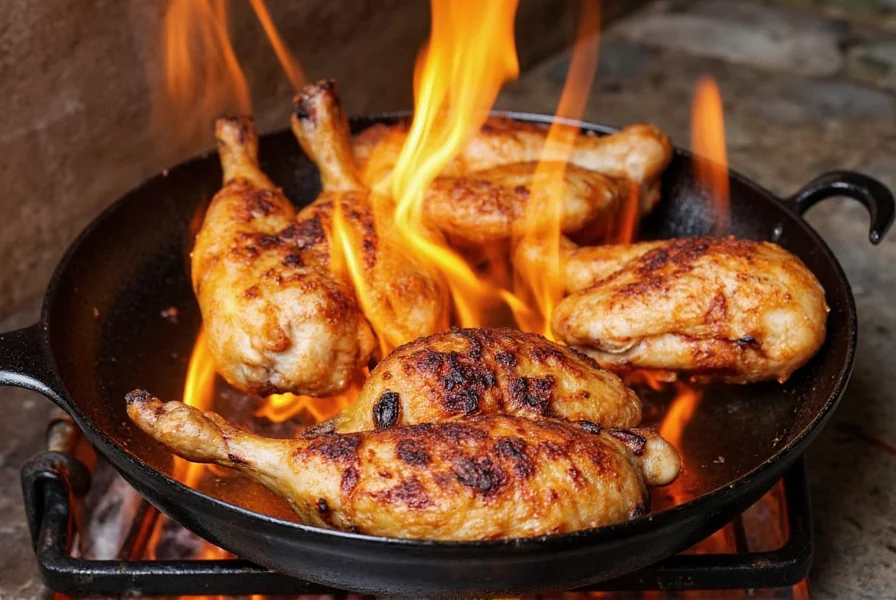Blackened Chicken Grill: Fire, Flavor, and a Little Drama on the Plate
When it comes to bold flavors and dramatic flair, few dishes can compete with a perfectly executed blackened chicken grill. Whether you're cooking up a storm on your backyard grill or searing away in the kitchen, blackening is more than just a technique — it's a flavor explosion wrapped in a crispy, smoky crust.
Table of Contents
- What Is Blackened Chicken?
- The Spice Blend That Brings the Heat
- Essential Tools for Grilling Success
- Step-by-Step Guide to Perfectly Blackened Chicken
- Buying Guide: Choosing the Best Equipment & Spices
- Serving Suggestions & Pairings
- Common Mistakes (And How to Avoid Them)
- Conclusion
What Is Blackened Chicken?
The term "blackened" might sound intimidating — like you've left the chicken on the fire one second too long — but in culinary terms, it's a carefully controlled process of searing meat in a very hot cast iron skillet or directly over high heat until a deep, flavorful crust forms. The signature char comes from the spices caramelizing under intense heat, not from burning.
Originally popularized by chef Paul Prudhomme in the 1980s, blackened chicken became a staple of Cajun cuisine. It’s now a go-to technique for anyone who loves big, smoky flavors with a little crunch.
The Spice Blend That Brings the Heat
The magic behind blackened chicken lies in the spice blend. While there are countless variations, a classic blackening seasoning typically includes:
- Paprika
- Cayenne pepper
- Garlic powder
- Onion powder
- Thyme
- Oregano
- Black pepper
- Salt
| Spice | Flavor Profile | Heat Level |
|---|---|---|
| Paprika | Smoky, sweet | Low |
| Cayenne | Earthy, spicy | High |
| Thyme | Herbal, earthy | None |
| Oregano | Robust, peppery | None |
| Garlic Powder | Savory, pungent | None |
Mix equal parts of each ingredient, adjusting cayenne according to your desired heat level. For extra depth, consider adding smoked paprika or a pinch of ground mustard seed.
Essential Tools for Grilling Success
To achieve that perfect blackened crust at home, you'll need the right equipment. Here's what not to skip:
- Cast Iron Skillet: Ideal for high-heat searing.
- Grill Pan: Offers great sear marks and even heat distribution.
- Meat Thermometer: Ensures safe internal temperatures without overcooking.
- Fire Extinguisher: Safety first! High heat = potential smoke alarms.
Step-by-Step Guide to Perfectly Blackened Chicken
- Prep Your Chicken: Use boneless, skinless chicken breasts or thighs. Pat dry thoroughly for better crust formation.
- Rub Generously: Coat both sides with melted butter or oil, then press the spice blend into the meat.
- Heat Up: Preheat your cast iron skillet or grill pan until it's smoking hot — about 400°F (204°C).
- Sear Like a Pro: Cook each side for 3–5 minutes until the spices form a dark, aromatic crust.
- Rest Before Serving: Let the chicken rest for 5–10 minutes to lock in juices.
Buying Guide: Choosing the Best Equipment & Spices
If you're new to blackened chicken or looking to upgrade your gear, here's a breakdown of what to look for:
| Product | Description | Advantages | Use Case |
|---|---|---|---|
| Staub Cast Iron Skillet | Heavy-duty skillet with superior heat retention | Durable, oven-safe, excellent for high-heat searing | Perfect for indoor blackening when weather won't allow grilling |
| Weber Grill Pan | Cast iron pan with raised ridges for sear marks | Evens out hot spots, gives authentic grill texture | Ideal for stovetop use or over charcoal |
| Texas Seasoning Co. Blackening Rub | Premixed blackening seasoning with balanced heat | Consistent flavor, no guesswork needed | Great for beginners or time-crunched cooks |
| Thermapen Mk4 Thermometer | Fast-read digital thermometer | Accurate within seconds, helps avoid under/overcooking | Essential for ensuring juicy, safe chicken |
Target Audience: Home cooks, professional chefs, and spice enthusiasts looking to elevate their grilling game.
Serving Suggestions & Pairings
Blackened chicken shines best when paired with complementary flavors that balance its intensity:
- Cool Sides: Try coleslaw, cornbread, or avocado lime crema.
- Grains: Serve with rice pilaf or quinoa for a hearty meal.
- Drinks: A crisp lager or a citrus-forward IPA will cut through the richness.
Common Mistakes (And How to Avoid Them)
Even seasoned grillers can stumble when blackening chicken. Here’s what to watch out for:
- Mistake #1: Not Drying the Chicken Enough – Moisture prevents a good crust. Always pat dry before seasoning.
- Mistake #2: Using Too Low Heat – You need high temps to activate the spices and build that signature crust.
- Mistake #3: Crowding the Pan – Cook in batches to ensure even browning.
- Mistake #4: Skipping the Rest – Letting the meat rest locks in juices and improves texture.

Conclusion
Blackened chicken grill isn’t just a dish — it’s an experience. From the moment the spices hit the hot metal to the final bite of juicy, smoky goodness, this method turns simple ingredients into something unforgettable.
With the right spice blend, proper tools, and a bit of courage to crank up the heat, you’re well on your way to mastering one of the most exciting techniques in modern grilling. So light that burner, grab your cast iron, and get ready to blacken like a pro.
Got questions? Drop them in the comments below! And don’t forget to share your blackened creations using the hashtag #BlackenedBrigade.










 浙公网安备
33010002000092号
浙公网安备
33010002000092号 浙B2-20120091-4
浙B2-20120091-4